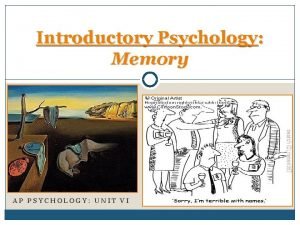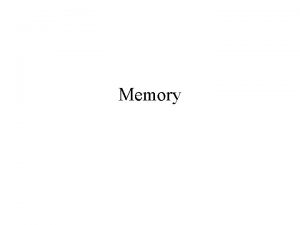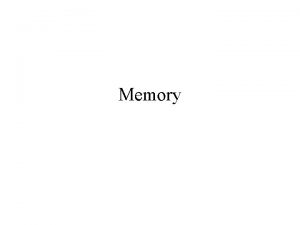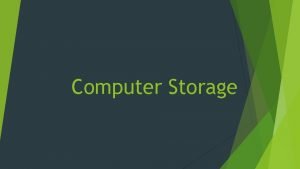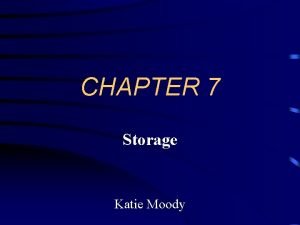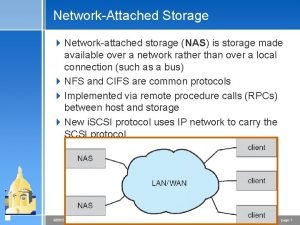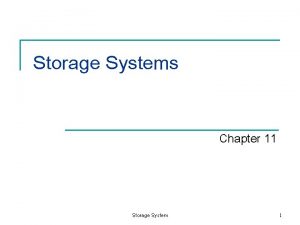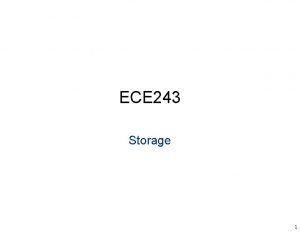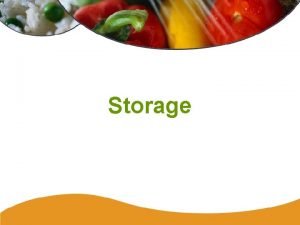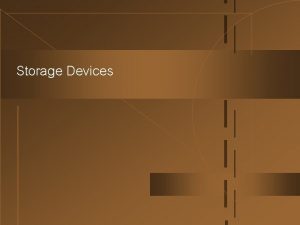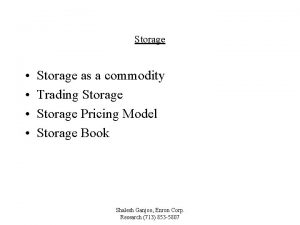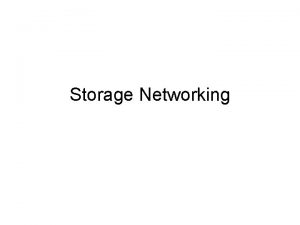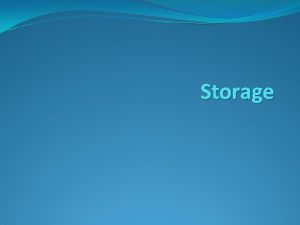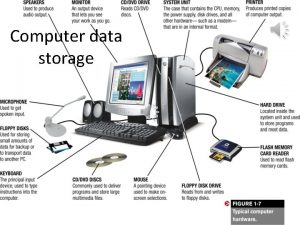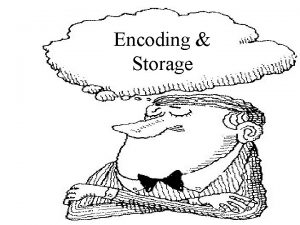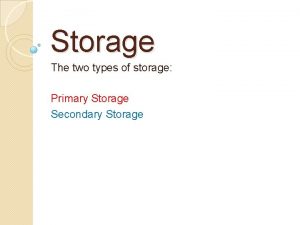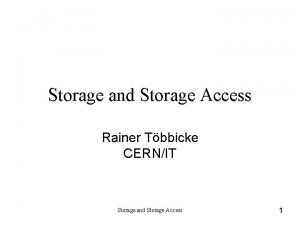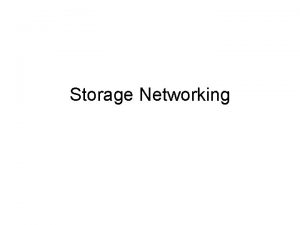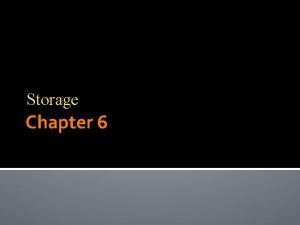MEMORY PROCESS OF MEMORY MEMORY The processing storage




















































- Slides: 52

MEMORY PROCESS OF MEMORY

MEMORY The processing, storage and retrieval of information acquired through learning.

ENCODING • information into a useable form so that it can be and in memory • the time of information in memory over STORAGE • the process of and the stored information from memory so that we are aware of it RETRIEVAL

ENCODING • information into a useable form so that it can be and in memory • the time of information in memory over STORAGE • the process of and the stored information from memory so that we are aware of it RETRIEVAL

ENCODING • converting information into a useable form so that it can be represented and stored in memory • the retention of information in memory over time STORAGE RETRIEVAL • the process of locating and recovering the stored information from memory so that we are consciously aware of it

Effortful Automatic

ATKINSON-SHIFFRIN MULTISTORE MODEL

ATKINSON-SHIFFRIN


STRUCTURAL FEATURES • Permanent, built-in fixed features that do not vary • Include the amount of information each store can hold (storage capacity) and storage duration (length of time it can be held there)

CONTROL PROCESSES • Selected and used by each individual and may vary in different situations. • E. g. attention – what you choose to attend to. • E. g. rehearsal – what you rehearse to transfer to LTM • E. g. retrieval – the search strategy chosen to retrieve the information

SENSORY MEMORY The entry point of memory where new incoming sensory information is stored for a very brief period.

SENSORY MEMORY • May have an unlimited capacity • Impressions overlap (continuum) rather than disconnected • Pen – visual sensory memory • Buffer – held long enough to be transferred • Not consciously aware of most information • Not transferred – it becomes lost

Sensory registers Iconic memory (visual) Echoic memory (auditory)

ICONIC MEMORY • Retain visual images in iconic memory for 1/3 second • Hand • Continuum – figure of 8 with sparklers • Sperling’s research

GEORGE SPERLING 1960 • You will be flashed a set of letters. • Recall as many as possible on a piece of paper.

G K B L M V X P R W Z C


J H W X P N J M T V Z K


GEORGE SPERLING 1960 • 1/20 second • Most could only recall 4 -5 • Short exposure – impossible to recall


Stephen Wiltshire https: //www. youtube. com/watch? v=bs. Jb. Ap. Z 5 GF 0


1 What colour is the girl’s dress? 2 Where are the girl’s arms? 3 Is the cat looking to its right or its left? 4 How many red flower ‘spikes’ are there? 5 What colour is the girl’s hair? 6 How many stripes are there on the bottom of the girl’s dress?

ECHOIC MEMORY Auditory sensory memory; that is, the brief sensory memory for incoming auditory information

ECHOIC MEMORY Info stays longer - 3 -4 seconds Echoic memory stores the tail-end while the previous information is being processed.


SHORT-TERM MEMORT (STM) A memory system with limited storage capacity in which information is stored for a relatively short time, unless renewed in some way. STM stores information temporarily, but for a longer time than sensory memory (and less than LTM).

STM In STM, the information is no longer an exact replica of the sensory stimulus, but an encoding (or representation) of one. Holds the information you are consciously aware of.

DURATION OF STM • Info retains well for the first few seconds • After 12 seconds recall declines • After 18 seconds, almost all information disappears

PETERSON AND PETERSON Remember the following trigrams. qlg jfb mwt rpy

PETERSON AND PETERSON Count backwards by threes from 634 When the lights flash, right down the trigrams.

PETERSON AND PETERSON Remember the following trigrams. pdt wqk dlm kgb

PETERSON AND PETERSON • Count backwards by fours from 781 • When the lights flash, right down the trigrams.

PETERSON AND PETERSON Remember the following trigrams. qdx tgw czx cqf

PETERSON AND PETERSON • Count backwards by sixes from 915 • When the lights flash, right down the trigrams.

CAPACITY Digit Span Test handout

CAPACITY OF STM I went to the supermarket…

CAPACITY OF STM Read these numbers and then without looking at the screen immediately write them down: 7, 2, 9, 4, 1, 8, 3

CAPACITY OF STM Read these numbers and then without looking at the screen immediately write them down: 4, 9, 1 , 7, 3, 8, 6, 2, 9, 5, 7

CAPACITY OF STM 7 pieces of information plus or minus 2 7± 2

STM AS WORKING MEMORY The term working memory emphasises the part of memory where information is temporarily held and actively ‘worked on’ as we undertake our everyday tasks. Working memory enables us to consciously use information from both sensory memory and LTM.


MAINTENANCE REHEARSAL Maintenance rehearsal involves repeating the information being remembered over and over again so that it can be retained (or ‘maintained’) in STM (or working memory).

MAINTENANCE REHEARSAL Try with: 7, 9, 1, 6, 3, 4, 2, 5, 9

ELABORATIVE REHEARSAL The process of linking new information in a meaningful way with other new information or information already stored in LTM to aid in its storage and retrieval from LTM Self-reference effect

CHUNKING You will hear a set of numbers called. Listen to the number. When I say ‘Go’, write down the numbers.

CHUNKING 59824 731259 5239461 14962573 315429635 8693652174 48374692741 402738491268

CHUNKING The grouping, or ‘packing’, of separate bits of information into a larger single unit, or ‘chunk’, of information. E. g. phone numbers

CHUNKING You will hear a set of numbers called. Listen to the numbers. When I say ‘Go’, write down the numbers.

CHUNKING 423 -19 267 -198 390 -675 -2 573 -291 -43 721 -354 -456 245 -619 -830 -2 141 -384 -515 -89 201 -315 -426 -762
 Transferring of data from auxiliary storage to main storage
Transferring of data from auxiliary storage to main storage Secondary storage vs primary storage
Secondary storage vs primary storage Secondary storage provides temporary or volatile storage
Secondary storage provides temporary or volatile storage Object based and unified storage
Object based and unified storage Top down procesing
Top down procesing Gloria suarez
Gloria suarez Bottom-up processing examples
Bottom-up processing examples Neighborhood processing
Neighborhood processing Examples of secondary processing
Examples of secondary processing Point processing in image processing
Point processing in image processing Histogram processing in digital image processing
Histogram processing in digital image processing Parallel processing vs concurrent processing
Parallel processing vs concurrent processing Nonlinear image processing
Nonlinear image processing Point processing in image processing
Point processing in image processing Thinning and thickening in image processing example
Thinning and thickening in image processing example Bottom up vs top down psychology
Bottom up vs top down psychology Batch processing and interactive processing
Batch processing and interactive processing Priming memory
Priming memory Short term memory computer
Short term memory computer Hát kết hợp bộ gõ cơ thể
Hát kết hợp bộ gõ cơ thể Frameset trong html5
Frameset trong html5 Bổ thể
Bổ thể Tỉ lệ cơ thể trẻ em
Tỉ lệ cơ thể trẻ em Gấu đi như thế nào
Gấu đi như thế nào Glasgow thang điểm
Glasgow thang điểm Chúa yêu trần thế alleluia
Chúa yêu trần thế alleluia Các môn thể thao bắt đầu bằng tiếng chạy
Các môn thể thao bắt đầu bằng tiếng chạy Thế nào là hệ số cao nhất
Thế nào là hệ số cao nhất Các châu lục và đại dương trên thế giới
Các châu lục và đại dương trên thế giới Công thức tính độ biến thiên đông lượng
Công thức tính độ biến thiên đông lượng Trời xanh đây là của chúng ta thể thơ
Trời xanh đây là của chúng ta thể thơ Cách giải mật thư tọa độ
Cách giải mật thư tọa độ Phép trừ bù
Phép trừ bù độ dài liên kết
độ dài liên kết Các châu lục và đại dương trên thế giới
Các châu lục và đại dương trên thế giới Thơ thất ngôn tứ tuyệt đường luật
Thơ thất ngôn tứ tuyệt đường luật Quá trình desamine hóa có thể tạo ra
Quá trình desamine hóa có thể tạo ra Một số thể thơ truyền thống
Một số thể thơ truyền thống Cái miệng bé xinh thế chỉ nói điều hay thôi
Cái miệng bé xinh thế chỉ nói điều hay thôi Vẽ hình chiếu vuông góc của vật thể sau
Vẽ hình chiếu vuông góc của vật thể sau Biện pháp chống mỏi cơ
Biện pháp chống mỏi cơ đặc điểm cơ thể của người tối cổ
đặc điểm cơ thể của người tối cổ V cc
V cc Vẽ hình chiếu đứng bằng cạnh của vật thể
Vẽ hình chiếu đứng bằng cạnh của vật thể Fecboak
Fecboak Thẻ vin
Thẻ vin đại từ thay thế
đại từ thay thế điện thế nghỉ
điện thế nghỉ Tư thế ngồi viết
Tư thế ngồi viết Diễn thế sinh thái là
Diễn thế sinh thái là Dot
Dot Số.nguyên tố
Số.nguyên tố Tư thế ngồi viết
Tư thế ngồi viết

















